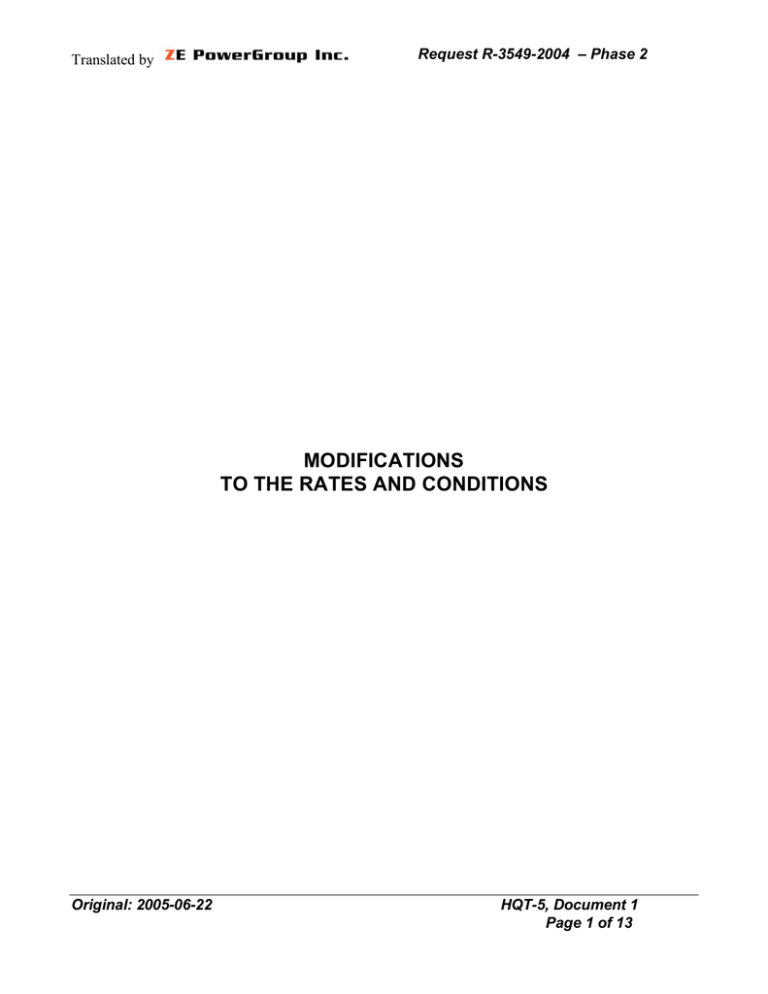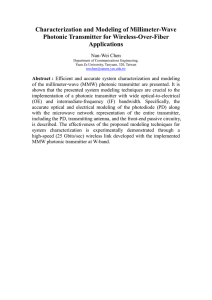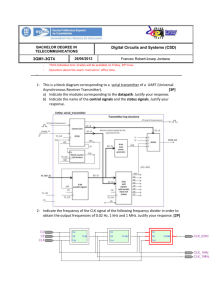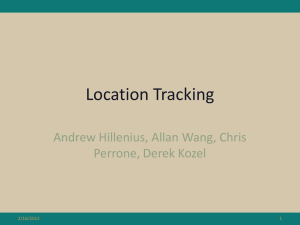MODIFICATIONS TO THE RATES AND CONDITIONS Translated by
advertisement

Translated by Request R-3549-2004 – Phase 2 MODIFICATIONS TO THE RATES AND CONDITIONS Original: 2005-06-22 HQT-5, Document 1 Page 1 of 13 Translated by Original: 2005-06-22 Request R-3549-2004 – Phase 2 HQT-5, Document 1 Page 2 of 13 Translated by Request R-3549-2004 – Phase 2 TABLE OF CONTENTS 1. INTRODUCTION ......................................................................................... 5 2. CONNECTION OF POWER STATIONS ..................................................... 6 3. HQT POINT ................................................................................................. 8 4. NETWORK ADDITIONS FOR TEMPORARY SERVICE ............................. 9 5. SOLVENCY AND CREDIT RISK MANAGEMENT ..................................... 9 6. CO M PLEMENTARY SERVICES............................................................... 10 7. EMERGENCY ENERGY............................................................................. 12 8. POINT-TO-POINT TRANSMISSION SERVICE AGREEMENTS ................. 12 9. PRIORITY FOR THE USE OF THE INTERCONNECTIONS....................... 12 Original: 2005-06-22 HQT-5, Document 1 Page 3 of 13 Translated by Original: 2005-06-22 Request R-3549-2004 – Phase 2 HQT-5, Document 1 Page 4 of 13 Request R-3549-2004 – Phase 2 Translated by 1 1. INTRODUCTION 2 The Transmitter presents to the Régie certain modifications to the Transmission 3 service rates and conditions of Hydro-Quebec ("Rates and conditions") 4 that it judges necessary in order to, in particular, meet the needs of its customers 5 as well as the expectations of the Régie and to ensure the compatibility of its 6 transmission services with those of neighboring networks. 7 Section HQT-5, Document 2 presents the list of the proposed modifications 8 to the Rates and conditions, with a summary description of the appropriate 9 justifications in each case. 10 In addition, section HQT-5, Document 3 presents the revised version of the 11 Rates and conditions in which all the proposed changes, relative 12 to the current version of the Rates and conditions authorized by the Régie in 13 in decision D-2004-122 of June 17, 2004, are indicated, either in the margins 14 for the withdrawals, or by underlining, for the additions. 15 The principal modifications proposed affect the 16 following subjects in particular; these modifications are then justified more 17 amply by the Transmitter: 18 • connection of power stations; 19 • HQT point; 20 • additions to the network for temporary service; 21 • solvency and credit risk management; 22 • complementary services; 23 • emergency energy; 24 • point-to-point transmission service agreements. Original: 2005-06-22 HQT-5, Document 1 Page 5 of 13 Request R-3549-2004 – Phase 2 Translated by 1 In addition, the Transmitter provides a progress report on the priority of use of 2 the interconnections, without however proposing additional modifications to 3 the Rates and conditions. 4 2. CONNECTION OF POWER STATIONS 5 The Transmitter proposes to add to the Rates and conditions certain provisions 6 relating to the connection of power stations to the transmission network, taking 7 into account the fact that a customer can connect a power station and then use it 8 to subscribe to more than one transmission service. 9 In addition, it is also possible that the owner of the generating 10 stations is a commercial entity distinct from the transmission service 11 customer, for example following a call for tenders of Hydro-Quebec in its 12 activities of distribution (the "Distributor") for the purchase of electricity, or in 13 the case of purchases of electricity of Hydro-Quebec Generation (the 14 "Generator") from private producers connected to the network. 15 Also, the Transmitter proposes the addition of a new article 12A to the Rates 16 and conditions including the following provisions: 17 • the signature, by the owner of the generating stations, of a 18 connection agreement substantially equivalent to the umbrella agreement 19 available on Internet site of the Transmitter, that does not constitute 20 a transmission service reservation, but rather with the intent to 21 to come to an agreement with the owner of a power station on a set of 22 terms relating to the connection and operation of the power station; 23 • the respect, by the owner of the power station, of the connection 24 requirements of the Transmitter, as well as the 25 authorized disturbances emission limits. Original: 2005-06-22 HQT-5, Document 1 Page 6 of 13 Translated by Request R-3549-2004 – Phase 2 1 It is equally envisioned to offer to the owner of the power station, or a third party that it 2 indicates for this purpose, the following choices relating to the engagements that 3 he must take when additions to the network envisioned in the Appendix J of the 4 Rates and conditions are carried out: 5 • signature of a long-term point-to-point service agreement 6 whose present value is at least equal to the costs assumed by the 7 Transmitter to ensure the integration of the power station; or 8 • signature of a "take or pay" type point-to-point service purchasing 9 agreement for an amount equal in present value to the costs 10 assumed by the Transmitter to ensure the integration of the power station; 11 or 12 13 • a refund to the Transmitter for an amount equal to the present value of the costs assumed by the Transmitter to ensure the integration of the power station. 14 Such engagements are not necessary when the production of the power station 15 constitutes a designated resource of the Distributor and that it was retained by 16 this latter following a call for tenders. 17 The purpose of these provisions are to ensure the economic neutrality of the costs 18 assumed by the Transmitter for the connection of power stations to its network, 19 by ensuring he will obtain revenues at least equal to these costs following the 20 connection of a power station. 21 Provisions relating to the chronological order in which the power station 22 connection requests are handled according to the principle of first come, 23 first serve, on the condition however that the time frames stated in the Rates 24 and conditions are respected, are also added. Finally, 25 provisions relating to a request for an exploratory study for the 26 connection of a power stations are added. Original: 2005-06-22 HQT-5, Document 1 Page 7 of 13 Translated by Request R-3549-2004 – Phase 2 1 3. POINT HQT 2 On page 22 of its decision D-2002-286, the Régie requires the Transmitter 3 to submit a report on the use of point HQT at the time of its next rate case. 5 The use of point HQT allows all customers of the Transmitter 6 to identify a single point for receptions and deliveries to the 7 network of the Transmitter. Thus, for a greater clarity in the use of 8 point HQT, the Transmitter propose to replace the name of point 9 "HQT-Montreal" indicated to the Rates and conditions by the name of point 10 "HQT", in order to better illustrate that this point is not connected to a specific part 11 of the transmission network. 12 In fact, point HQT has the effect of granting a large flexibility to the customers 13 of the Transmitter in their choice of the means they use to respond to 14 their needs and this, even if the points of connection to the transmission network 15 are different. Thus, any customer who has more than one equipment 16 of production on the network, can use one or the other of these equipments 17 to carry out its point-to-point service reservation. 18 In the same spirit, the Transmitter proposes to revise the definition of the 19 HQT point, so that it includes all the sites on the transmission network, 20 other than the points of interconnection with neighboring networks 21 indicated on the OASIS site of the Transmitter. Original: 2005-06-22 HQT-5, Document 1 Page 8 of 13 Request R-3549-2004 – Phase 2 Translated by 1 4. ADDITIONS TO THE NETWORK FOR TEMPORARY SERVICE 2 The Transmitter proposes to establish a distinct ceiling for the costs that he 3 assumes for additions to its network in the case of a temporary service of more 4 than one year, for example in the case of the supply of a power station 5 construction site, this in order to prevent that the cost assumed by the 6 Transmitter be higher than the revenues arising from the rendered service. It is 7 proposed in this case that the ceiling be established in proportion to the duration of 8 the temporary service, relative to a twenty-year duration, in present value. 9 5. 10 Because of the many changes experienced by North American 11 electricity markets in recent years, the 12 Transmitter recently carried out a review of its counterpart risks 13 management policy, in order to make sure that all the customers who carry out 14 transmission service reservations have the adequate financial capacity 15 to respect their commitments with the Transmitter. 16 Following this exercise, certain customers having a service agreement in 17 force no longer meet the credit requirements stipulated in article 11 of the 18 Rates and conditions. The Transmitter has put in place measures 19 to make sure that the requests for reservation of these customers are not 20 accepted as long as the credit requirements of the 21 Transmitter will not be satisfied. 22 Therefore, the Transmitter proposes to modify article 11 of the Rates and 23 conditions in order to better surround the rules of solvency and credit 24 management of counterparts and thus, to reduce the risk of bad debts. SOLVENCY AND CREDIT RISK MANAGEMENT Original: 2005-06-22 HQT-5, Document 1 Page 9 of 13 Request R-3549-2004 – Phase 2 Translated by 1 6. COMPLEMENTARY SERVICES 2 The complementary services associated with the integrated network point-to-point 3 services are indicated in appendices 1 to 7 of the Rates and conditions. Those 4 necessary for the supply of the local load, in addition to those proposed in 5 Appendix 1, are described in Appendix 8 of the Rates and conditions. 6 The Transmitter proposes the following modifications to the Rates and conditions: 7 1) For point-to-point transmission services: 8 9 • to add the compensation service for variations in reception (appendix 4) 2) For the local load supply service (appendix 8): 10 • to withdraw the compensation service for variations in reception, 11 • to withdraw the produced wave quality maintenance service. 12 Complementary service for the point-to-point service 13 The compensation service for variation in reception is necessary in order to 14 to compensate for the differences between the quantity of scheduled energy and that 15 actually delivered by the producer, when the source of this production 16 is located in the control zone of the Transmitter. Compensation 17 service for variations in reception is similar in its application to the existing 18 compensation service for variations in delivery. The customer can 19 acquire this service from the Transmitter or conclude comparable agreements 20 with other suppliers whose generating stations are located 21 in the control zone of the Transmitter. 22 The Transmitter also proposes to specify in the corresponding 23 appendices of the Rates and conditions that frequency regulation services 24 (appendix 3), maintenance of the revolving reserve (appendix 6) and of maintenance 25 of the supplementary reserve (appendix 7), be provided by the Transmitter for 26 all transactions on the network and not only when the transmission service Original: 2005-06-22 HQT-5, Document 1 Page 10 of 13 Translated by Request R-3549-2004 – Phase 2 1 is used to supply a customer in the control zone of the 2 Transmitter. This will allow the Transmitter to invoice these services to 3 inter-network transmissions that benefit from the aforesaid services, but that are 4 not currently invoiced. Moreover, it is necessary to specify that when the 5 customer buys these services directly from another supplier, the service must be 6 provided by installations located in the control zone of the Transmitter. 7 Supplementary services for the local load 8 The Transmitter proposes to withdraw two services currently included in appendix 9 of the 9 Rates and Conditions, the compensation service for variation of 10 reception and the produced wave quality maintenance service. 11 The compensation service for variation in reception is intended 12 to compensate for the differences between the quantity of scheduled energy and that 13 actually delivered by the producers to the transmission network. In the case of the 14 supply of the local load, it is the Distributor that is responsible 15 to foresee in its procurement agreements the consequences of such 16 variations and to put in place supply mechanisms 17 to mitigate them if necessary. It is thus not the responsibility of the Transmitter 18 to include this service in the Rates and conditions for the supply of the local 19 load. 20 As for the maintenance of the quality of the produced wave, it is not a 21 supplementary service provided by the Distributor, but a provision envisioned 22 in the requirements for the connection of power stations and loads, which apply 23 to the load and generating stations connected at the request of the 24 Distributor, as with those of any other customer of the transmission services. 25 This service must thus be withdrawn from appendix 8. Original: 2005-06-22 HQT-5, Document 1 Page 11 of 13 Request R-3549-2004 – Phase 2 Translated by 1 7. EMERGENCY ENERGY 2 Provisions are added to the Rates and conditions to specify the 3 responsibilities of the parties when the Transmitter requests the assistance of a 4 neighboring network in an emergency situation on the one hand, and when he 5 provides emergency energy in response to a request for assistance of a nearby 6 network, on the other. This is a situation somewhat particular to Quebec, 7 since in other jurisdictions, the provisions relating to emergency energy 8 are part of the existing market rules. In the case of 9 the Transmitter, he must intervene to ensure emergency energy and he 10 must foresee the mechanisms to refund the suppliers of emergency 11 energy. 12 8. 13 The Transmitter proposes to maintain the requirement of a distinct service 14 agreement, applicable to each request for long term point-to-point service 15 (Appendix A) and to introduce a single umbrella service agreement 16 applicable to all short-term point-to-point services, firm and 17 non-firm (Appendix B), since in this last case, the customer can 18 carry out many reservations of short-term point-to-point service 19 on the OASIS system of the Transmitter, without obviously having to sign 20 each time a new service agreement. 21 9. 22 The Transmitter does not propose to modify the provisions relative to the 23 prioritization for the use of the interconnections, since after examining them 24 it appears that any potential conflict for the use of the interconnections 25 to supply the local load or the point-to-point transmission service can POINT-TO-POINT TRANSMISSION SERVICE AGREEMENT PRIORITY FOR THE USE OF THE INTERCONNECTIONS Original: 2005-06-22 HQT-5, Document 1 Page 12 of 13 Request R-3549-2004 – Phase 2 Translated by 1 be resolved adequately by the application of the current provisions of 2 Parts II, III and IV of the Rates and conditions. 3 The priorities for the use of the interconnections are presented summarily 4 in Table 1 below: Table 1 – Priorities for the use of the interconnections Delivery (export) 1. Firm long-term point-to-point service (One year or more) (export) 2. Firm short-term point-to-point service 2.1 Monthly 2.2 Weekly 2.3 Daily 3. n.a. 4. Non-firm short-term point-to-point service 4.1 Monthly 4.2 Weekly 4.3 Daily 4.4 Hourly Reception (importation) 1. Service for the supply of the local load with a designated resource of the (importation) Distributor for the same duration, as well as firm long-term point-to-point service (one year or more) 2. Service for the supply of the local load with a designated resource of the Distributor for the same duration, as well as firm short-term point-to-point service 2.1 Monthly 2.2 Weekly 2.3 Daily 3. Service for the supply of the local load with a non-designated resource 4. Non-firm short-term point-to-point service 4.1 Monthly 4.2 Weekly 4.3 Daily 4.4 Hourly 5 In any event, the Distributor can indicate, without additional expenses, 6 the firm capacity that he needs to import from neighboring networks during 7 the necessary periods. Moreover, the Distributor and the Generator also can 8 use non-designated resources, once again without additional expenses, 9 to supply the load local, with an interconnections use priority 10 higher than that of a non-firm point-to-point service. Original: 2005-06-22 HQT-5, Document 1 Page 13 of 13






